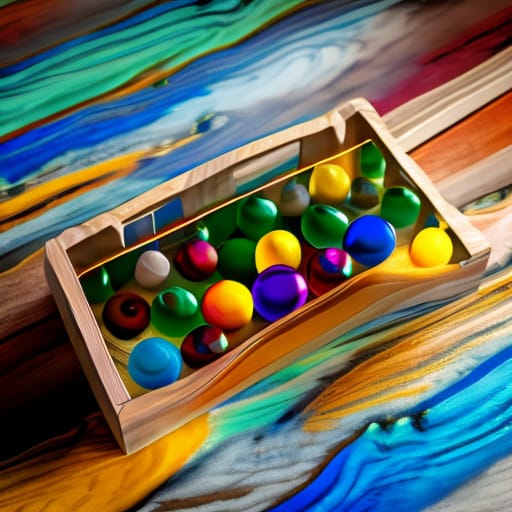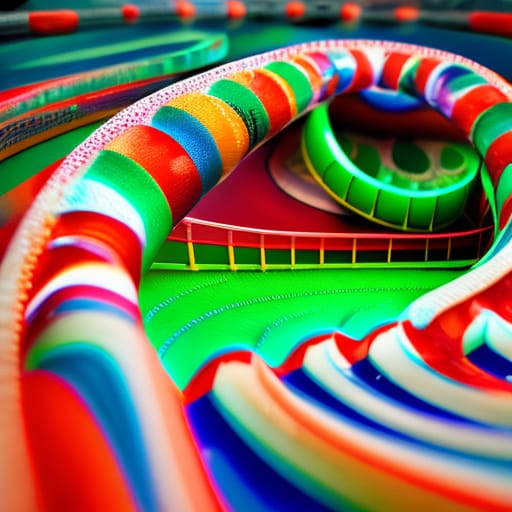Marble maze building blocks are a classic toy that provides hours of enriching play. These ingenious sets allow children to construct winding tracks, tunnels, ramps and other structures to send marbles racing in endlessly captivating runs.
As both an engaging plaything and a tool for developing key skills, marble runs have stood the test of time. Read on to learn all about how marble maze building blocks work, their many benefits for young minds, and the most popular and creative sets on the market today.
How Do Marble Run Building Blocks Work?
Marble runs or marble racers are made up of interlocking plastic or wooden pieces that allow children to build looping and zigzagging courses almost entirely based on their imagination.
Once built, marbles are dropped at the top of the structure and navigate downward, gathering speed as they hit ramps and zip through curves, popping out the other end in a flashy finish.
Marble run kits contain:
- Marbles – Typically glass or metal balls that roll down the tracks. Part of the fun is mixing colors and sizes.
- Tracks – Straight tubes, curved pieces, funnels and more that marbles roll through.
- Ramps, launchers – Moving parts like conveyor belts, paddle wheels that propel the marbles.
- Start/finish gates – Decorative gates to insert marbles and catch them at the end.
- Connectors – For joining tracks at angles or in alignment.
- Base mat – A soft, grippy surface to prevent pieces from slipping.
Beyond these standard components, some sets feature advanced add-ons like puzzles, timers and mechanical elements allowing even more customization as kids’ abilities grow.

The Many Benefits of Marble Run Toys
Open-ended marble runs engage a child’s senses, creativity and critical thinking in unique ways modern digital toys often lack.
As your child constructs then observes their marble run creations in action, they gain several key developmental benefits:
Enhances Spatial Reasoning
Visualizing and designing structures requires strong spatial reasoning skills. Marble runs encourage kids to develop this aptitude as they map out each intersection and curve needed to achieve their desired tracks.
Develops Planning and Problem-Solving
The constructive play of marble runs is an exercise in trial-and-error problem solving. When marbles fly off course, kids must determine why and alter their existing design or start anew – all while planning their next attempt.
Promotes Creativity and Self-Expression
Marble runs allow kids to translate the tracks they envision into tangible structures. No two runs ever turn out the same as kids give each creation their own personal twist.
Fosters Engineering and Science Concepts
As marbles whirl through ramps, pivots and pendulums, children gain an intuitive grasp of principles like gravity, velocity, momentum, centrifugal force, and kinetic energy.
Enhances Fine Motor Control
The process of constructing marble runs is an excellent workout for young hands. Connecting numerous small pieces together boosts dexterity, grip strength and bilateral coordination.
With all these perks bundled into an engaging play experience kids love, it’s easy to see why marble runs are a toy with true staying power.
Key Developmental Areas Marble Runs Enhance
As discussed earlier, marble run play taps into multiple facets of early learning. Here’s a closer look at 3 vital skills marble maze building kits help cultivate:
Spatial Reasoning and Visualization
Marble runs are essentially modular spatial puzzles for young minds.
To construct functional tracks, kids must be able to visualize how parts rotate and interconnect in a structured sequence.
This entails spatial sequencing – picturing how each new piece will fit relative to prior ones. It also activates spatial visualization – manipulating 3D objects and pathways in the mind’s eye.
As they gain competence visualizing abstract structures, children strengthen the neural pathways related to manipulating spatial relationships.
This mental aptitude is linked to success in fields like engineering, architecture, artwork, mechanics and geometry down the road.
Critical and Logical Thinking
When marbles veer offline or get stuck, marble runs transform into thrilling cause-and-effect puzzlers.
“Why did my marble pop out early on that last run?” kids will ask themselves. “What should I try next?”
This kickstarts critical thinking as children analyze issues. It also spurs logical reasoning as they strategize new solutions.
Evaluating their setup, ruling out ideas that don’t work, then devising and testing new structures demands strong analytical skills.
Persisting through several cycles of iterative prototyping to achieve a desired end solidifies habits of cognitive flexibility. Kids learn to monitor their own thinking and change course as needed – just as professional designers do.
Gross and Fine Motor Skills
On the physical front, assembling marble runs is like playful resistance training for developing hands and limbs.
Connecting crossbeams, twisting funnel pieces into slots, attaching ramps at steep angles – all help strengthen kids’ finger muscles and wrist mobility.
The bilaterality and hand-eye sync required boosts overall manual dexterity. Simultaneously, all the physical construction and play sharpens gross motor abilities.
As they gain bodily control and confidence through marble runs, kids build a key foundation for activities like sports, dance, instrument playing and DIY making later on.
Marble Run Inspired STEM Learning
The principles of gravity, acceleration, energy transfers and more seen in marble runs offer natural jumping-off points for engaging science instruction.
Parents and teachers can easily correlate marble maze activities to key STEM and physics topics like:
- Gravity and acceleration
- Kinetic/potential energy
- Volume, mass and density
- Measurement of speed and velocity
- Friction, momentum and inertia
- Trajectory angles and modelling
- Simple machine mechanics
Tying marble runs to fundamental forces and systems shows how science comes alive through play.
Constructing a more complex marble run is also a perfect project for teaching the engineering design process. Walk kids through steps like:
- Defining problems (desired structure)
- Brainstorming ideas
- Designing and prototyping
- Testing and evaluating
- Refining their designs
Emphasizing this iterative cycle not only builds resilience and grit – it nurtures a true working understanding of how real-world engineering unfolds.

Final Thoughts
As a category, marble runs have proven their staying power as a toy that nurtures young minds across eras.
Their simplicity combined with near-endless variability and customizability makes marble maze building kits a perfect spark for creativity. Kids never play with marble runs the same way twice.
While enticing children into the joy of hands-on tinkering, marble runs also sneakily develop vital spatial skills, critical thinking and manual dexterity through play.
Given these well-rounded developmental upsides, marble runs deserve a spot among the classic toys that best stand the test of time and trends.
Top 15 Marble Run FAQs
What are the most affordable marble run sets?
Quality entry-level marble run sets from Melissa & Doug, Playmags and Kidkraft can be found for around $25-35. Check sales on Amazon or in learning toy catalogs.
What makes a marble get stuck in a run?
Check that funnels and tubes aren’t obstructed. Make sure tracks are properly aligned so marbles roll smoothly across connectors. Misconnections are the top cause of stuck marbles.
Can I build a marble run that does loops?
Yes! With enough long, gradually curving pieces, you can create corkscrews and vertical loops. Position a curve at the bottom to “catch” marbles with enough speed from above.
Which marble maze building sets are biggest?
For giant marble runs, the Tegu Explorer set has 400+ pieces to construct over 5-foot structures. Other extra large sets come from brands like KidKraft, Graham Plays, Playmags andSimplify3D Marble Run.
What are the best marble runs for preschoolers?
Prioritize easy connections like snap-fit tracks, chunkier pieces, and smooth ball-bearing wheels. Melissa & Doug, Lakeshore Learning, and Orbrium make top marble runs for toddlers.
What add-ons can make marble runs more exciting?
Motorized conveyors, traps like swinging gates, alternate pathways controlled by levers, and obstacles to push past all add interactivity. Electronic features like digital timers, light-up tracks, and sound effects provide fun feedback.
How can I customize or expand my marble run set?
Many popular marble run brands use compatible track diameters, letting you integrate parts across kits. You can also DIY elements using everyday items like paper towel tubes, funnels, plastic bottles, masking tape and cardboard.
Which skills do marble runs improve the most?
Marble runs especially help boost spatial reasoning, visualization, planning, problem-solving, and fine motor control. Building them also teaches key engineering and physics concepts in an applied setting.
Can marble run kits be used for competitions or races?
Absolutely! Build dual tracks with start gates for kids to race marbles simultaneously. Or create relay or obstacle runs to challenge speed and precision. Addition of timers or finish lines with bells/buzzers amps up the excitement.
Where can I find marble run project ideas or lesson plans?
Sites like Frugal Fun for Boys and Girls, Science Sparks and Little Bins for Little Hands have hundreds of DIY marble run templates, STEM challenges and free printable activities to try.
